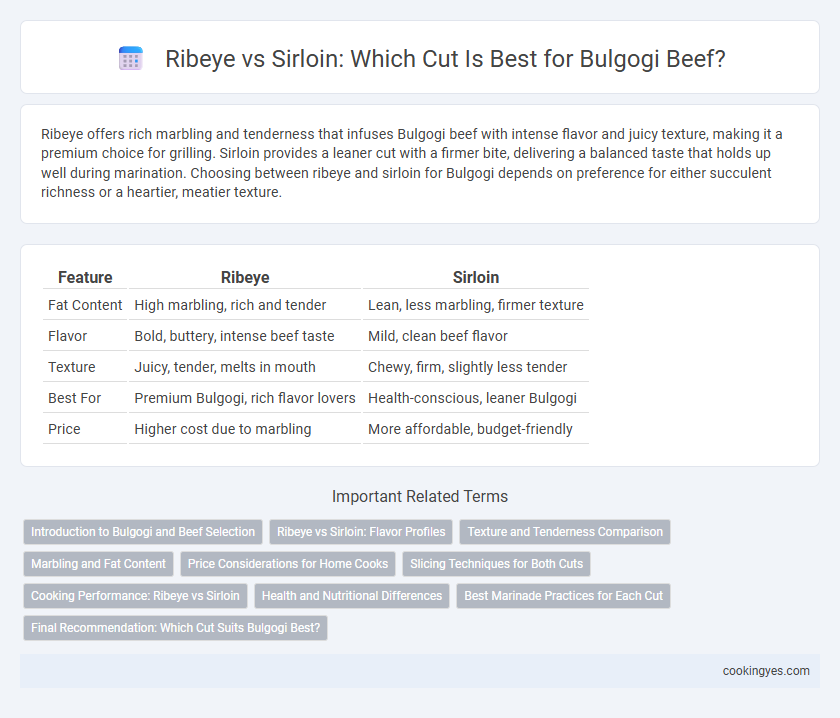Ribeye offers rich marbling and tenderness that infuses Bulgogi beef with intense flavor and juicy texture, making it a premium choice for grilling. Sirloin provides a leaner cut with a firmer bite, delivering a balanced taste that holds up well during marination. Choosing between ribeye and sirloin for Bulgogi depends on preference for either succulent richness or a heartier, meatier texture.
Table of Comparison
| Feature | Ribeye | Sirloin |
|---|---|---|
| Fat Content | High marbling, rich and tender | Lean, less marbling, firmer texture |
| Flavor | Bold, buttery, intense beef taste | Mild, clean beef flavor |
| Texture | Juicy, tender, melts in mouth | Chewy, firm, slightly less tender |
| Best For | Premium Bulgogi, rich flavor lovers | Health-conscious, leaner Bulgogi |
| Price | Higher cost due to marbling | More affordable, budget-friendly |
Introduction to Bulgogi and Beef Selection
Bulgogi, a traditional Korean grilled marinated beef dish, demands tender and flavorful cuts for the best taste experience. Ribeye offers rich marbling and tenderness, enhancing juiciness and depth of flavor, while sirloin provides a leaner option with a slightly firmer texture and a clean, beefy taste. Selecting the right cut influences the balance between tenderness and boldness, making ribeye ideal for indulgent Bulgogi and sirloin a healthier alternative with satisfying chew.
Ribeye vs Sirloin: Flavor Profiles
Ribeye offers a rich, buttery flavor with marbling that enhances juiciness and tenderness, making it ideal for Bulgogi's sweet and savory marinade to deeply penetrate the meat. Sirloin provides a leaner, beefier taste with a firmer texture, resulting in a slightly chewier bite that highlights the marinade's balance without overwhelming the palate. Choosing ribeye emphasizes a melt-in-your-mouth experience, while sirloin delivers a robust, meaty flavor with a satisfying bite in Bulgogi dishes.
Texture and Tenderness Comparison
Ribeye offers a richer marbling with a tender, juicy texture that melts in the mouth, making it ideal for Bulgogi's sweet, savory marinade to penetrate deeply. Sirloin provides a leaner cut with a firmer texture, delivering a slightly chewier bite, which adds a satisfying contrast when grilled. Choosing ribeye enhances tenderness and flavor absorption, while sirloin offers a beefier chew that balances Bulgogi's tender profile.
Marbling and Fat Content
Ribeye is preferred for Bulgogi due to its superior marbling and higher fat content, which enhances tenderness and flavor during grilling. Sirloin offers a leaner option with less intramuscular fat, resulting in a firmer texture and a slightly less rich taste. Optimal Bulgogi flavor and juiciness are achieved when using well-marbled ribeye cuts.
Price Considerations for Home Cooks
Ribeye typically commands a higher price than sirloin due to its higher marbling and tenderness, making it a premium choice for Bulgogi. Home cooks aiming for budget-friendly options often prefer sirloin as it provides a balance between affordability and flavor without compromising the dish's authenticity. Selecting sirloin enables cost-effective meal preparation while still delivering juicy, flavorful Bulgogi suitable for everyday cooking.
Slicing Techniques for Both Cuts
Ribeye for Bulgogi benefits from thin, cross-grain slicing to enhance tenderness and marbling absorption, emphasizing the cut's rich fat distribution. Sirloin requires careful trimming of sinew before slicing against the grain into uniformly thin strips to maintain chewiness while maximizing flavor infusion. Both cuts demand precision in slicing thickness--approximately 1/8 inch--to ensure quick, even cooking and optimal marinade penetration.
Cooking Performance: Ribeye vs Sirloin
Ribeye offers superior juiciness and marbling, resulting in tender, flavorful Bulgogi that cooks quickly and retains moisture. Sirloin provides a leaner cut with a firmer texture, which can yield a chewier bite but offers a cleaner, beefy flavor when thinly sliced. Choosing ribeye enhances cooking performance with rich taste and tenderness, whereas sirloin requires careful cooking to avoid toughness.
Health and Nutritional Differences
Ribeye offers higher fat content and marbling, providing rich flavor and tender texture but also increased saturated fats and calories compared to sirloin. Sirloin is leaner with less fat, making it a healthier option for those focusing on lower cholesterol and calorie intake while still retaining a robust beef flavor. Choosing sirloin for Bulgogi enhances nutritional benefits by reducing fat consumption without sacrificing protein quality.
Best Marinade Practices for Each Cut
Ribeye's rich marbling absorbs marinades quickly, making it ideal for a soy-based mixture with garlic, ginger, and sesame oil to enhance its tender texture. Sirloin, leaner and slightly firmer, benefits from a marinade incorporating sugar and pear juice to tenderize while balancing its robust beef flavor. Both cuts should marinate for at least 30 minutes but no longer than 2 hours to prevent overpowering the natural meat taste and maintain optimal juiciness.
Final Recommendation: Which Cut Suits Bulgogi Best?
Ribeye offers superior marbling and tenderness, making it ideal for juicy, flavorful Bulgogi that melts in the mouth. Sirloin provides a leaner option with a firmer texture, suitable for those preferring a less fatty, chewier bite. For authentic, melt-in-your-mouth Bulgogi, ribeye is the best choice due to its balanced fat content and rich flavor.
Ribeye vs Sirloin for Bulgogi beef Infographic

 cookingyes.com
cookingyes.com